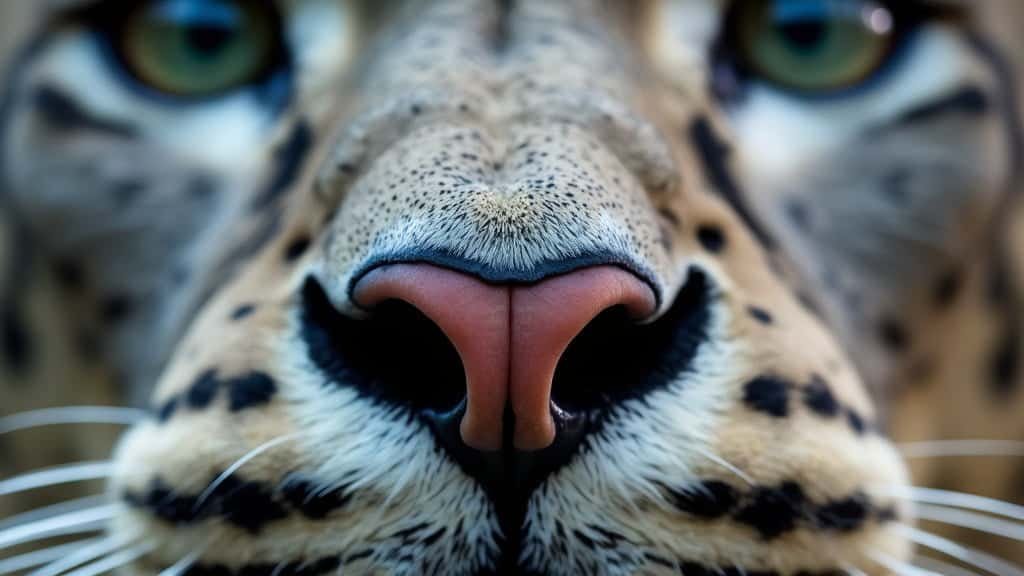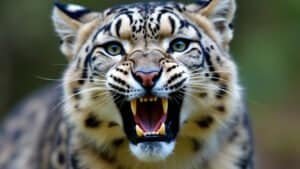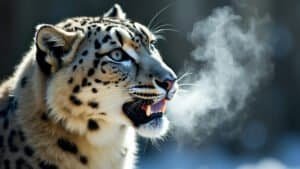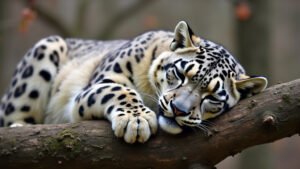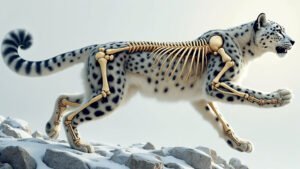Introduction
Snow leopards are remarkable creatures that thrive in some of the coldest and most unforgiving environments on Earth. One of the key factors that enable them to survive such harsh conditions is their highly specialized nasal passages, which are adapted to warm and humidify the frigid air they breathe
In this article, we will explore how these adaptations work, focusing on the intricate structures within the nose, such as nasal turbinates, and their vital role in respiratory health. We will also compare these adaptations to those of other big cats and cold-climate animals to understand their unique effectiveness
How Snow Leopards’ Nasal Passages Warm Cold Air
Snow leopards, native to the cold mountain ranges of Central and South Asia, have evolved unique adaptations to cope with their frigid environment
One of the most critical adaptations lies in their nasal passages, which are specifically designed to warm the cold air they inhale. This ability is essential for maintaining their core body temperature and ensuring that the air reaching their lungs is at a safe temperature
The process begins as the snow leopard breathes in cold, dry air through its nostrils. Unlike humans, whose nasal passages are relatively straightforward, the snow leopard’s nasal cavity is complex and expansive. This complex structure plays a significant role in modifying the incoming air
As the cold air travels through the nasal passages, it is warmed by the surrounding blood vessels that line the walls of the nasal cavity. These blood vessels are closer to the surface in snow leopards than in many other animals, which allows them to transfer heat to the incoming air more effectively
This process is critical because it prevents the cold air from cooling down the body’s core temperature, which could otherwise lead to hypothermia
The Importance of Warming Air for Snow Leopards
The harsh environments where snow leopards live, such as the Himalayas, Altai, and Tien Shan mountains, can experience temperatures as low as -40°F. In such extreme conditions, inhaling cold air directly into the lungs could be life-threatening
The body’s internal organs are not equipped to handle air this cold, so the role of the nasal passages in warming the air becomes crucial. By the time the air reaches the lungs, it needs to be at a temperature that will not damage the delicate lung tissue
The warming process in the nasal passages helps ensure this, allowing snow leopards to maintain their health and continue hunting and surviving in these icy habitats
Structures in the Nose that Aid in Warming
The snow leopard’s nasal cavity is lined with specialized structures known as turbinates. These are thin, scroll-like bones covered with mucous membranes. Turbinates increase the surface area within the nasal passages, creating a larger area for heat exchange between the incoming air and the blood vessels
The increased surface area allows more time and space for the cold air to be heated before it travels further down the respiratory tract. Additionally, the mucous membranes on the turbinates help to humidify the air, adding moisture that prevents the airways from drying out and getting irritated by the cold, dry air
Moreover, the shape and arrangement of the turbinates in snow leopards are particularly well-suited for extreme cold. They are more elaborate and complex than those found in many other species, reflecting the snow leopard’s adaptation to a life spent mostly in freezing temperatures
This intricate structure not only warms but also slows down the airflow, giving the nasal passages more time to condition the air
Differences in Nasal Adaptations Compared to Other Big Cats
When compared to other big cats like lions or tigers, the snow leopard’s nasal adaptations are more advanced for cold environments. Lions, for example, live in warmer climates where such extensive nasal structures are unnecessary
Their nasal passages are shorter and less convoluted, reflecting their need to cool rather than warm the air they breathe. Tigers, which live in a range of climates including colder regions, have nasal adaptations that fall somewhere in between
While they do have turbinates and other structures to help warm the air, they are not as complex as those in snow leopards, because tigers do not inhabit environments that are as consistently cold
The Role of Nasal Turbinates in Snow Leopards
Nasal turbinates play a central role in the snow leopard’s ability to survive in cold climates. These intricate bony structures within the nasal cavity are essential for both warming and humidifying the air that the snow leopard breathes in
Turbinates are a common feature in mammals, but in snow leopards, they are particularly well-developed to handle the extreme cold of their mountainous habitats
The nasal turbinates in snow leopards are composed of thin, curled bones that are covered with a mucous membrane. This membrane is richly supplied with blood vessels, which help to transfer heat from the blood to the air passing through the nasal passages
The layout and complexity of these turbinates create a large surface area within a relatively small space, maximizing the efficiency of heat exchange. This ensures that even in the coldest conditions, the air entering the lungs is warmed sufficiently to prevent any potential damage to the respiratory system
What Are Nasal Turbinates?
Nasal turbinates, also known as conchae, are spiral-shaped bones located inside the nasal cavity. Their primary function is to regulate airflow and to increase the surface area inside the nose
This increased surface area allows for more effective warming, humidifying, and filtering of the air before it reaches the lower respiratory tract. The turbinates are covered with a mucous membrane that traps particles and moisture from the air, adding another layer of protection against the cold and dry conditions often found in the snow leopard’s environment
The design of nasal turbinates is such that they create a turbulent airflow within the nasal passages. This turbulence forces the air to come into contact with the mucous membrane more frequently, enhancing the exchange of heat and moisture
In snow leopards, this process is especially important, as the cold air they breathe needs to be conditioned before it reaches the lungs
How Turbinates Function in Cold Weather
In the extreme cold of the snow leopard’s natural habitat, breathing in frigid air directly could be harmful, potentially leading to frostbite in the respiratory tissues or other cold-related injuries
The nasal turbinates mitigate this risk by warming the air as it passes through the nasal passages. The extensive network of blood vessels within the turbinates releases heat, which is absorbed by the cold air. This process is so effective that by the time the air reaches the lungs, its temperature has risen significantly, preventing any potential damage to the respiratory system
Additionally, the turbinates help to conserve moisture within the body. As the cold air is humidified by the mucous membranes, moisture is added to the air, which is crucial for preventing the airways from drying out
In cold environments, the air is typically very dry, which can lead to dehydration of the respiratory tissues if not properly managed. The snow leopard’s turbinates, with their moist surfaces, ensure that the air retains enough humidity to keep the respiratory system healthy and functioning properly
Turbinates’ Contribution to Respiratory Health
The effective functioning of nasal turbinates is vital for the overall respiratory health of snow leopards. By warming and humidifying the air, turbinates prevent the respiratory system from being exposed to the damaging effects of cold, dry air
This not only protects the lung tissues but also helps in maintaining the general health and stamina of the snow leopard, which is crucial for survival in its harsh environment
Moreover, the turbinates play a role in filtering out dust and other particles that may be present in the cold, dry air of high altitudes. The mucous membrane covering the turbinates traps these particles, preventing them from reaching the lungs and causing potential infections or irritations
This filtration process is especially important in environments where snow leopards may encounter wind-borne debris or fine dust from rocky terrains
Survival Benefits of Nasal Adaptations in Snow Leopards
The survival of snow leopards in some of the most extreme environments on Earth is largely dependent on their unique nasal adaptations
These adaptations, which include the specialized nasal passages and turbinates, provide critical benefits that go beyond merely warming and humidifying the air
They play a key role in maintaining the overall health and functionality of the snow leopard’s respiratory system, directly impacting its ability to hunt, reproduce, and thrive in its harsh mountain habitats
Impact on Snow Leopards’ Health
The harsh cold of the mountainous regions where snow leopards reside poses significant challenges to any living organism. For snow leopards, breathing in such cold air could lead to severe health issues if their bodies were not equipped to handle it
The nasal adaptations of snow leopards are crucial in preventing conditions like frostbite within the respiratory tract and reducing the risk of respiratory infections, which could be life-threatening in the wild
One of the most significant health benefits provided by these adaptations is the prevention of hypothermia. By warming the air before it reaches the lungs, the snow leopard’s nasal passages help maintain the animal’s core body temperature
This is essential for sustaining the high levels of energy required for hunting and other daily activities. Additionally, the humidification of the air prevents dehydration of the respiratory tissues, which could otherwise lead to chronic respiratory issues and a weakened immune system
How These Adaptations Prevent Respiratory Issues
The ability of the snow leopard’s nasal passages to condition the air they breathe is critical for avoiding respiratory problems that could arise from exposure to extremely cold and dry air
Respiratory tissues are sensitive to temperature and humidity levels; without adequate warming and humidification, these tissues can become damaged, leading to complications such as bronchitis or pneumonia
Moreover, the mucus-covered turbinates trap pathogens, dust, and other particulates that might be present in the air. This filtration process reduces the likelihood of infections that could compromise the snow leopard’s ability to hunt or move through its environment efficiently
The constant filtration and humidification provided by the nasal structures ensure that snow leopards breathe clean, moist air, even in the harshest conditions
Comparison with Other Cold-Climate Animals
Snow leopards are not the only animals that have developed nasal adaptations to survive in cold climates. Many other cold-climate mammals, such as Arctic foxes, polar bears, and reindeer, also possess similar nasal structures designed to warm and humidify the air
However, the snow leopard’s adaptations are particularly advanced due to the extreme altitudes and temperatures they encounter
For example, Arctic foxes also have nasal turbinates that help warm the air, but the complexity and size of these structures are less pronounced than in snow leopards, reflecting the differences in their respective environments
Polar bears, which live in coastal and ice-covered regions, have turbinates that are effective for warming the air, but they do not need to humidify it as extensively due to the higher humidity levels in their environment compared to the dry mountain air faced by snow leopards
In reindeer, which also inhabit cold environments, the nasal turbinates play a dual role in warming the air and conserving body heat by recapturing heat from exhaled air. This process is somewhat similar to that of snow leopards, but the reindeer’s adaptation is more focused on energy conservation, while the snow leopard’s adaptation is more about preventing direct damage from cold air
The comparison highlights the unique challenges that snow leopards face, and how their nasal adaptations have evolved to meet these specific demands. Unlike animals that live in more stable cold environments, snow leopards must cope with high altitudes, extreme cold, and dry air, all of which require more sophisticated adaptations
Conclusion
Snow leopards have evolved highly specialized nasal adaptations that are crucial for their survival in the extreme cold of their mountainous habitats
These adaptations, including complex nasal passages and intricate turbinates, allow snow leopards to warm and humidify the frigid air they breathe, protecting their respiratory system from potential damage
The effectiveness of these adaptations is evident in how they prevent issues like hypothermia and respiratory infections, enabling snow leopards to maintain their health and energy levels necessary for survival in harsh environments
By comparing these adaptations to those of other cold-climate animals, it becomes clear that snow leopards are uniquely equipped to thrive in some of the most challenging conditions on Earth
